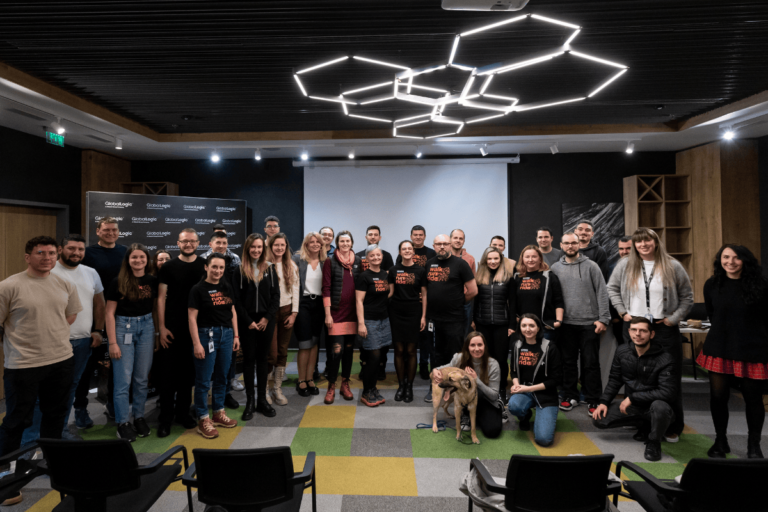- Services
Technology Capabilities
Technology Capabilities- Product Strategy & Experience DesignDefine software-driven value chains, create purposeful interactions, and develop new segments and offerings
- Digital Business TransformationAdvance your digital transformation journey.
- Intelligence EngineeringCreate high-value products faster with AI-powered and human-driven
- Software Product EngineeringCreate high-value products faster with AI-powered and human-driven engineering.
- Technology ModernizationTackle technology modernization with approaches that reduce risk and maximize impact.
- Embedded Engineering & IT/OT TransformationDevelop embedded software and hardware. Build IoT and IT/OT solutions.
- Industries
- GlobalLogic VelocityAI
- Insights
White PapersSeptember 17, 2024Diana SocaciuElevating Romanian Tourism with GlobalLogic: Apuseni App
The innovative banking apps, such as the one we'll explore in this case study, succeed ...
 Case StudiesGlobalLogic
Case StudiesGlobalLogicFrom Legacy to Leading-edge: A Global Software Leader’s ...
Discover how GlobalLogic’s AI-powered solutions helped a global software leader migrate...

- About
Published on April 5, 2025Engineering the Future of Healthcare: 6 Trends Driving the Next Era of Digital Health
View all articles Krishna PadmanabhanSenior Vice President & General Manager, Healthcare & LifesciencesShareRelated Content
Krishna PadmanabhanSenior Vice President & General Manager, Healthcare & LifesciencesShareRelated Content GlobalLogic3 December 2025
GlobalLogic3 December 2025 GlobalLogic27 November 2025View All Insights
GlobalLogic27 November 2025View All Insights GlobalLogic25 November 2025Recommended authorsDirector, Industrial BU GSPSenior Vice President & Head of EMEAView all authorsVice President & Consumer Business, Americas GlobalLogic
GlobalLogic25 November 2025Recommended authorsDirector, Industrial BU GSPSenior Vice President & Head of EMEAView all authorsVice President & Consumer Business, Americas GlobalLogicLet's start engineering impact together
GlobalLogic provides unique experience and expertise at the intersection of data, design, and engineering.
Get in touchAI-Powered SDLCAnalyticsData EngineeringHealthcare and Life SciencesThe healthcare industry is entering a new phase defined by complex demands and fast-moving innovation. As care delivery expands beyond hospital walls and patients take a more active role in their health, organizations are under pressure to modernize with speed and purpose.
Meeting that challenge takes more than adopting new technologies. It requires rethinking how healthcare is designed, delivered, and experienced, from the systems clinicians rely on to the tools patients use every day.
Across the healthcare ecosystem, six trends are reshaping what’s possible. For leaders deciding what to build next — and how to engineer it — these shifts offer a clearer view of where the industry is headed and what it will take to stay ahead.
1. AI-Driven Medical Software Will Become the New Frontline of Care
Software as a Medical Device (SaMD) is emerging as a foundational pillar of modern healthcare, transforming how patients are diagnosed, treated, and monitored. No longer limited to companion apps or data visualization tools, today’s SaMD solutions are increasingly intelligent, connected, and integral to clinical decision-making. With the integration of algorithms and machine learning, SaMD is enabling real-time analysis, predictive insights, and adaptive therapies that personalize care at scale.
Unlike traditional healthcare software, SaMD are regulated as medical devices and perform medical functions independently of a physical device. As AI becomes more embedded in these products, they’re enabling smarter decision support, adaptive therapies, and connected care that extends beyond the clinic, across the care continuum.
This advanced capability brings technical and regulatory complexity. To build a SaMD that is both intelligent and compliant, development teams must embed safety, security, and risk management into every stage of the product lifecycle while navigating regulatory frameworks that are evolving to keep pace with technical innovation.
As patient and care providers’ expectations continually increase, MedTech companies are embracing SaMD not just as a product, but as a platform — a scalable, secure, and compliant foundation for continuous innovation that engages the patient, improves outcomes, and reduces avoidable interventions.
2. Embedded Intelligence Will Redefine Connected Care Devices
As connected medical devices move beyond supporting care to delivering it, embedded software is becoming the control layer for real-time decision-making, continuous monitoring, and adaptive therapies. This shift is changing how healthcare organizations think about product design, data, and infrastructure.
The future of embedded systems isn’t just about adding connectivity. It’s about engineering autonomy into devices that can operate safely and intelligently at the edge. Devices need to process data locally, respond in milliseconds, and remain secure and compliant without constant oversight.
That requires cross-disciplinary development, from real-time systems and sensor calibration to cloud integration and regulatory alignment. It also calls for robust software architectures that support continuous validation and lifecycle updates.
This is where embedded innovation is headed: systems that are not just connected, but capable. Devices that can learn, adapt, and scale care beyond traditional settings — without compromising performance or trust.
Recommended reading – AI-Powered Insights Transform Patient Data into Better Healthcare Outcomes
3. System Interoperability Will Make or Break Digital Health Ecosystems
As digital health expands, so does the complexity of the systems behind it. New platforms, devices, and data sources are entering the care continuum, but most still struggle to work together. Interoperability is no longer a technical hurdle. It’s a strategic necessity.
The ability to integrate clinical, operational, and patient-generated data is what separates scalable health solutions from siloed pilots. Organizations that can securely exchange and act on real-time data will unlock faster care decisions, more personalized services, and operational efficiency that scales.
But true interoperability goes beyond APIs. It requires unified data models, standards-based integration, and platforms that support orchestration across fragmented systems. As patient journeys become more digital, connected systems must bridge settings, stakeholders, and technologies without adding friction or risk.
This is where forward-thinking leaders are investing—not just in tools that connect, but in infrastructure for connected healthcare systems that can evolve. Interoperability is no longer a checkbox. It’s the foundation for building digital ecosystems that support continuous insight, coordination, and innovation at scale.
4. Device Cybersecurity is a Regulatory and Brand Imperative
As medical devices become more connected and intelligent, the line between cybersecurity and patient safety is disappearing. A vulnerability in device software is no longer just a technical risk but can be a clinical risk as well.
Healthcare organizations are already seeing this shift reflected in regulation. Security is now a core expectation of FDA and EU MDR approval, not a post-market add-on. But regulatory compliance is only part of the equation. Patients and providers are placing greater trust in devices that gather sensitive health data and perform critical analysis. A security lapse can result in compromising patient safety, which will undermine both that trust and the brand behind it.
The challenge is that today’s devices are complex, distributed systems. Firmware, mobile apps, cloud services, AI models — they all interact, and every layer must be tested, verified, and monitored as part of a secure lifecycle. That includes threat modeling and risk assessment during development, security testing, ideally leveraging AI-powered test automation, during the verification and validation phase, vulnerability monitoring, and incident response after release.
Leading MedTech companies are treating security as more than a safeguard, they are positioning it as a differentiator. They’re building testing infrastructure that can scale across product lines and implementing processes that respond to emerging threats faster than traditional methods can. They are aligning cybersecurity with the same engineering process discipline that drives product innovation.
As risk moves from the data center to the device, cybersecurity is no longer just an IT responsibility. It’s a core product design principle and a brand leadership issue.
5. AI + Data Will Accelerate the Next Generation of Clinical Trials
AI, real-world evidence, and remote monitoring are changing how clinical trials are designed, managed, and measured, accelerating timelines and magnifying insight. The major trends reflect a shift toward greater efficiency, precision, and patient-centricity, driven by the increasing availability of real-world data, advancements in machine learning, and regulatory openness to digital tools.
This evolution comes at a critical moment. As trials grow more complex, the pressure to control costs, ensure data quality, and increase speed to market entry is growing.
In response, leading organizations are adopting intelligent clinical trial models that embed predictive analytics, AI-driven automation, and decentralized platforms from the outset.
These next-generation trials are more adaptive and insight-rich by design. AI is making recruitment more targeted by analyzing clinical histories and behavioral data, while real-world evidence supports smarter site selection and protocol optimization, reducing screen failures and dropouts.
AI and machine learning are also changing how trials are monitored. Early signal detection, anomaly spotting, and remote biosensing are enabling continuous oversight and faster response to emerging risks. Digital endpoints are making it possible to capture real-time outcomes across broader and more diverse populations.
This new phase of clinical research is faster, more inclusive, and more predictive. But its success hinges on a scalable, integrated data strategy. Organizations that treat AI and data as foundational infrastructure, not optional layers, will define the future of clinical trials.
Recommended reading – DeviceTalks Insights: AI in Medical Devices and the Future of Healthcare Technology Innovation
6. Patient Access Will Be Rebuilt Around Digital-first Journeys
Access to health information is now a core part of the care experience. Patients expect to connect with providers on their terms — online, on mobile, and across channels that feel familiar.
Healthcare organizations are moving beyond portals and call centers. They’re building digital entry points that simplify navigation, streamline scheduling, and support follow-through with timely reminders, virtual care options, and connected tools.
These experiences must be intuitive, secure, and deeply integrated with clinical systems. That includes syncing these entry points with EHRs, telehealth platforms, and third-party services to create a consistent view of the patient journey.
When done well, digital access improves adherence, reduces cognitive load, and increases satisfaction. It requires coordination across design, data, and systems engineering to deliver care that is responsive, scalable, and built around real patient needs.
What Comes Next: Engineering Safer, Faster, Intelligent Healthcare
The future of healthcare will be shaped by those who can engineer intelligence at every phase of innovation. From AI-powered diagnostics and connected devices to real-time clinical trials and personalized patient experiences, success depends on the ability to move faster, without compromising safety, quality, or compliance.
Meeting that challenge demands more than great ideas. It takes disciplined execution, scalable systems, and tools that deliver results across complex, regulated environments.
That’s where GlobalLogic delivers impact. With VelocityAI, we help MedTech leaders embed intelligence into the entire development lifecycle, accelerating innovation, streamlining validation, and transforming testing into a driver of continuous improvement.
Download our latest point of view, The Strategic Imperative of Automated Testing in Medical Devices, to see how AI-enabled automation is reshaping development and compliance—and why it’s essential for building the next generation of safe, scalable medical technology.
 How can I help you?
How can I help you?
Hi there — how can I assist you today?
Explore our services, industries, career opportunities, and more.
Powered by Gemini. GenAI responses may be inaccurate—please verify. By using this chat, you agree to GlobalLogic's Terms of Service and Privacy Policy.


